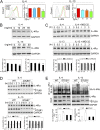Regulation of IL-4 receptor signaling by STUB1 in lung inflammation
- PMID: 24251647
- PMCID: PMC3919125
- DOI: 10.1164/rccm.201305-0874OC
Regulation of IL-4 receptor signaling by STUB1 in lung inflammation
Abstract
Rationale: IL-4Rα, the common receptor component for IL-4 and IL-13, plays a critical role in IL-4- and IL-13-mediated signaling pathways that regulate airway inflammation and remodeling. However, the regulatory mechanisms underlying IL-4Rα turnover and its signal termination remain elusive.
Objectives: To evaluate the role of STUB1 (STIP1 homology and U-Box containing protein 1) in regulating IL-4R signaling in airway inflammation.
Methods: The roles of STUB1 in IL-4Rα degradation and its signaling were investigated by immunoblot, immunoprecipitation, and flow cytometry. The involvement of STUB1 in airway inflammation was determined in vivo by measuring lung inflammatory cells infiltration, mucus production, serum lgE levels, and alveolar macrophage M2 activation in STUB1(-/-) mice. STUB1 expression was evaluated in airway epithelium of patients with asthma and lung tissues of subjects with chronic obstructive pulmonary disease.
Measurements and main results: STUB1 interacted with IL-4Rα and targeted it for ubiquitination-mediated proteasomal degradation, terminating IL-4 or IL-13 signaling. STUB1 knockout cells showed increased levels of IL-4Rα and sustained STAT6 activation, whereas STUB1 overexpression reduced IL-4Rα levels. Mice deficient in STUB1 had spontaneous airway inflammation, alternative M2 activation of alveolar macrophage, and increased serum IgE. STUB1 levels were increased in airways of subjects with asthma or chronic obstructive pulmonary disease, suggesting that up-regulation of STUB1 might be an important feedback mechanism to dampen IL-4R signaling in airway inflammation.
Conclusions: Our study identified a previously uncharacterized role for STUB1 in regulating IL-4R signaling, which might provide a new strategy for attenuating airway inflammation.
Figures








Comment in
-
IL-4Rα, a STUB-strate for proteasomal degradation: understanding the termination of cytokine signaling in asthma.Am J Respir Crit Care Med. 2014 Jan 1;189(1):4-6. doi: 10.1164/rccm.201311-2083ED. Am J Respir Crit Care Med. 2014. PMID: 24381986 No abstract available.
Similar articles
-
Transfer of in vivo primed transgenic T cells supports allergic lung inflammation and FIZZ1 and Ym1 production in an IL-4Rα and STAT6 dependent manner.BMC Immunol. 2011 Oct 20;12:60. doi: 10.1186/1471-2172-12-60. BMC Immunol. 2011. PMID: 22014099 Free PMC article.
-
IL-4Rα, a STUB-strate for proteasomal degradation: understanding the termination of cytokine signaling in asthma.Am J Respir Crit Care Med. 2014 Jan 1;189(1):4-6. doi: 10.1164/rccm.201311-2083ED. Am J Respir Crit Care Med. 2014. PMID: 24381986 No abstract available.
-
SERPINB10 promotes macrophage M2 polarization and airway inflammation in asthma.Respir Res. 2025 May 10;26(1):181. doi: 10.1186/s12931-025-03252-3. Respir Res. 2025. PMID: 40349036 Free PMC article.
-
IL-13 receptors and signaling pathways: an evolving web.J Allergy Clin Immunol. 2003 Apr;111(4):677-90; quiz 691. doi: 10.1067/mai.2003.1333. J Allergy Clin Immunol. 2003. PMID: 12704343 Review.
-
Interleukin-4, interleukin-13, signal transducer and activator of transcription factor 6, and allergic asthma.Curr Mol Med. 2008 Aug;8(5):384-92. doi: 10.2174/156652408785161032. Curr Mol Med. 2008. PMID: 18691065 Free PMC article. Review.
Cited by
-
IL-17A enhances IL-13 activity by enhancing IL-13-induced signal transducer and activator of transcription 6 activation.J Allergy Clin Immunol. 2017 Feb;139(2):462-471.e14. doi: 10.1016/j.jaci.2016.04.037. Epub 2016 Jun 11. J Allergy Clin Immunol. 2017. PMID: 27417023 Free PMC article.
-
Advances in the research of the role of macrophage/microglia polarization-mediated inflammatory response in spinal cord injury.Front Immunol. 2022 Dec 1;13:1014013. doi: 10.3389/fimmu.2022.1014013. eCollection 2022. Front Immunol. 2022. PMID: 36532022 Free PMC article.
-
Neurodevelopmental Disorders (NDD) Caused by Genomic Alterations of the Ubiquitin-Proteasome System (UPS): the Possible Contribution of Immune Dysregulation to Disease Pathogenesis.Front Mol Neurosci. 2021 Sep 8;14:733012. doi: 10.3389/fnmol.2021.733012. eCollection 2021. Front Mol Neurosci. 2021. PMID: 34566579 Free PMC article. Review.
-
[Effect of methyleugenol on expression of MUC5AC in nasal mucosa of rats with allergic rhinitis].Zhejiang Da Xue Xue Bao Yi Xue Ban. 2016 May 25;45(5):477-485. doi: 10.3785/j.issn.1008-9292.2016.09.05. Zhejiang Da Xue Xue Bao Yi Xue Ban. 2016. PMID: 28087907 Free PMC article. Chinese.
-
Update on the role of alternatively activated macrophages in asthma.J Asthma Allergy. 2016 Jun 3;9:101-7. doi: 10.2147/JAA.S104508. eCollection 2016. J Asthma Allergy. 2016. PMID: 27350756 Free PMC article. Review.
References
-
- Mirel DB, Valdes AM, Lazzeroni LC, Reynolds RL, Erlich HA, Noble JA. Association of IL4R haplotypes with type 1 diabetes. Diabetes. 2002;51:3336–3341. - PubMed
Publication types
MeSH terms
Substances
Grants and funding
LinkOut - more resources
Full Text Sources
Other Literature Sources
Medical
Molecular Biology Databases
Research Materials
Miscellaneous

